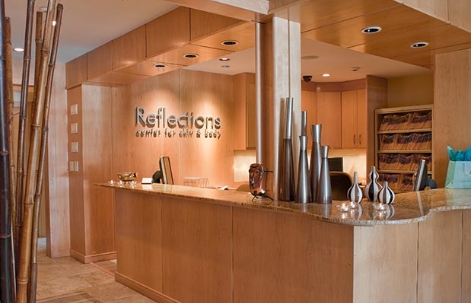Acne scarring is famously hard to get rid of. If it gets in the way of your clear, smooth skin goals, then it’s important to know that there have been a lot of new technologies to come out in the past few years that work really well to treat acne scars, but you want to be an educated consumer, because there’s a bit of nuance to getting the results you’re after.
At Reflections, our team of cosmetic physicians marries the best of new technologies, like lasers, Microneedling, and TCA Cross, with surgical techniques like subcision and excision, to create treatments for each and every type of acne scarring you might have.
What is Acne Scarring?
Acne scars most often look like textured bumps or divots in the skin that can sometimes be pigmented (red, purple, or brown). Although there are many different specific types of acne scars, the two main categories are hypertrophic (protruding) or atrophic (depressed). Common types of atrophic scars are ‘icepick’ scars, which are very small holes in the skin, and ‘boxcar’ scars which have steeply-angled sides and are similar to chickenpox scars. Both types can give the skin unwanted texture and feel, making it difficult to feel comfortable in your skin.
We’ve got a whole page that talks about types of acne scarring because most individuals have more than 1 type, but most practitioners treat only 1-2 types really well. So it’s important to have an idea of the types of scars you have, and the types of technologies that treat those scars well, so that you end up getting sold a treatment that isn’t going to treat everything that bothers you. For that same reason, we do offer free in-person consultations in our New Jersey offices with our doctors for acne scars, so that you can walk out informed about exactly what types of acne scars you’re dealing with, and what the options are to treat each kind.
What Causes Acne Scarring?
Acne scarring is usually the result of the skin’s attempts to heal itself after an acneic lesion. When a pore becomes clogged and swells, the pressure can damage the wall of the pore and cause breakage. Small breakages can often recover without difficulty and are unnoticeable— larger breakages, however, requires the skin to generate new collagen to repair the area. Sometimes, not enough collagen is created, resulting in a depression in the skin. Other times, too much collagen is created, resulting in a bump. Because of the rapid nature of your skin’s repair mechanisms after acne, this collagen is not always as smooth and even as the surrounding skin.
What Are the Best Treatments Acne Scarring in 2020?
Fractionated CO2 or resurfacing lasers used to be the gold standard in acne scar treatment. The problem was that they had a very long downtime, were very expensive, and the risk of complications in skin of color (Asian, Hispanic, Middle Eastern, or darker) was very high – to the point where most doctors wouldn’t touch skin of color with these lasers (and for good reason). Today we only use these lasers in the most aggressive treatments. There have been some advances made that allow us to use aggressive resurfacing lasers safely on skin of all colors and tones, but most patients are able to achieve good results without being as aggressive.
Lasers do still hold a vital place in the treatment of acne scars, especially in fair-skinned patients with discoloration issues (either red, purple, or brown) or textural and mild discoloration issues. But for the most part, we don’t use lasers for textural resurfacing because a new technology called RF Microneedling has proven to be excellent at this, and is safe for all skin types.
RF Microneedling is very different from the standard Microneedling. We almost never recommend dermapen-style Microneedling for acne scars in our practice. It simply does not create profound enough results for this kind of patient to meet our high standards of care. There are 2 reasons why Microneedling doesn’t create the big changes that RF Microneedling does:
- Microneedling is often done much more superficially than RF Microneedling – and legally when anyone other than a doctor performs Microneedling, it has to be at a more superficial depth
- RF Microneedling uses Radiofrequency (RF) energy to heat the skin. This creates thermal injury which triggers the body to create more collagen and resurface a much greater percentage of the skin with each treatment
We do like to combine Microneedling and laser treatments with injections derived by concentrating and isolating the platelets, growth factors, and healing factors from your own blood. Lasers and Microneedling (including RF Microneedling) work by creating tiny columns of injury in the skin. If you think about how your body closes a papercut with platelets, it starts to make more sense why we’d want to deliver that directly to the area being treated. By providing your own natural healing and growth factors right at the side of this micro-injury, we can help the body to heal faster and better than it would be able to on its own, and this creates more dramatic results with each treatment session (vs. sessions done without these injections).
For deeply indented scars, especially those with thick scar tissue, we tend to use subcision and volume replacement. This is an advanced injection technique that most injectors aren’t trained in. But if you have box car scars, this really smooths out the skin in a way lasers and Microneedling will never be able to.
For Ice pick scars, we like to use TCA cross, which causes the skin to close in these thin, deep scars.
As you can see, we really use the best tool for each type of scar – and that often means combining more than 1 treatment for our patients. This allows us to get our patients great results in as few treatments (and as little cost) as possible. You can check out our results in our before and after gallery.
Can My Dermatologist or Plastic Surgeon Help?
Although you may be tempted to schedule an appointment with your dermatologist, they and plastic surgeons can often be behind the times when it comes to acne scarring treatments.
Dermatologists are generally more focused on medical treatment of the underlying acne. Those that do offer cosmetic services are often offering just Microneedling and/or lasers. Typically, you won’t find a large selection of lasers or RF Microneedling devices at their offices, and since each technology really only does 1 thing well, patients often don’t get the most effective treatments as they could. Patients also won’t typically have access to MicroFat, subcision, or acne scar surgery at a dermatologist’s office.
Plastic surgeons tend to focus on surgical techniques, but acne scar surgery is highly specialized, and only a handful of cosmetic surgeons in the country really perform this procedure at a high level. Our office does offer acne scar surgery as an option for patients looking to get as much of a result as possible in a single procedure. Typically, however, plastic surgeons don’t do a good job of marrying surgical technique with the nonsurgical options. Surgical techniques can help you get rid of the big indentations, but that’s about it. You will still have widespread uneven texture and pigmentation (dark spots, red spots, etc.).
Schedule a Consultation
At Reflections, we’re proud to offer some of the leading treatment options for acne scarring in the industry. To meet with our cosmetic physicians and learn more about your options, contact our Martinsville and Livingston offices by calling or filling out our online form. Our patient care coordinators will be in touch to schedule a consultation with our cosmetic physicians to begin planning your ideal treatment package.







